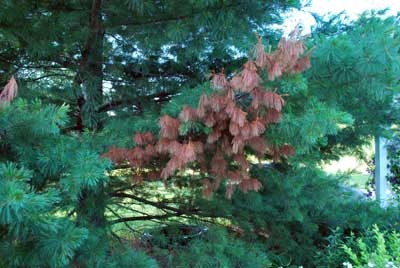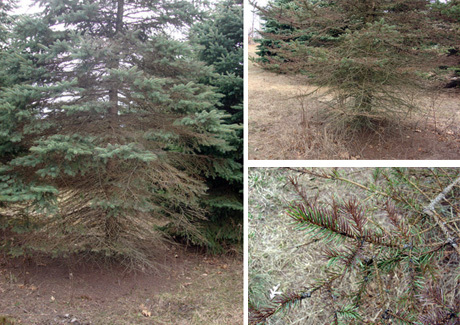|
Fungal Infestations of Pine and
Spruce– Have you taken a walk through your yard and noticed needles turning brown and falling off of branches on your white pine or blue spruce trees? A fungus is the most likely culprit and it is important to act quickly at the first sign of infestation, to prevent serious damage to or total loss of affected trees. White Pine Blister Rust (WPBR) is a fungus that originated in Asia and was accidentally brought from Germany to North America in infected seedlings at the turn of the 20th century. WBPR requires two host plants in order to complete its lifecycle. One is the pine tree (all five needle pines can be affected), and the other are Ribes, which are fruit-bearing plants, primarily some varieties of currants and gooseberries. Once the fungal infection establishes itself in the needles, it spreads through the branch, and if reaching the stem or trunk of the tree, it becomes lethal. Signs of infestation on the pines are small red or yellow spots on the needles. In a year or two you will notice swollen, yellow blisters on the branches. If a branch or trunk has blisters around its circumference, it is girdled, and will die from that point upward. Pines with severe infestation will have dead branches and dead tops. Infected Ribes have yellowish leaf spots, which may or may not be obvious. The spots will be followed by orange spores. The fungus does not spread from tree-to-tree. It requires both pines and Ribes to complete its lifecycle. There are ways to attempt to control WPBR, but they are not guaranteed to be 100% effective. These include:
For more information, visit http://migarden.msu.edu/uploads/files/e2747.pdfor http://www.forestpathology.org/dis_wpbr.html Cytospora canker and Rhizophaera Needle Cast are both fungi that affect Blue Spruce. Cytospora canker infestation is evidenced by needles that turn purple, then brown and drop from the tree. Trees that are overcrowded or stressed are particularly susceptible and the infection typically begins lower in the tree, usually entering the trunk at the branch site or through a wound. Some options for trying to control the disease include:
http://www.mortonarb.org/tree-plant-advice/article/748/spruce-diseases.html |
BIO:Anna and her husband Todd own Arcadia Gardens, LLC a Stevensville, MI based landscape design and build company. Her degree in Horticulture with a focus on landscape management from Michigan State University allows Anna to select plants specific to on-site conditions and with maintenance requirements that suit the client's needs. She is comfortable designing across a range of styles- from contemporary to classic- and makes a point to include the client's input throughout the design process. She is an active member of the Association of Professional Landscape Designers and is serving as 2014 President of the APLD-Michigan Chapter. Anna has recently contributed to media such as "The Designer" and Gardendesign.com and is qualified to speak on a variety of topics from landscape design and maintenance to addressing local garden clubs and organizations. Contact Us: |

